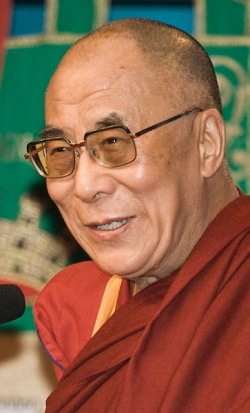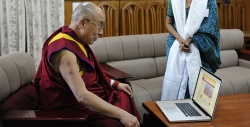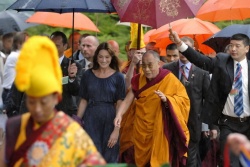The Dalai Lama: Saint or Sinner?
It’s fair to say that across the Western world the Dalai Lama has a very positive public image. His talks and conferences are always well attended, his books become bestsellers and his appeal to Holywood celebrities is legendary.
In the nineties there was even something of a ‘Tibet boom’ with a massive ‘Free Tibet’ concert/rally in 1996 featuring amongst others the Beastie Boys and the Red Hot Chilli Peppers, several films released focusing on Tibet & the Dalai Lama (Little Buddha, Kundun, 7 years in Tibet, etc.) and Steven Seagal was recognised as a reincarnation of a past Buddhist master (a tulku).
In recent years however another more critical response towards the Dalai Lama and Tibetan Buddhism has become increasingly common and it is emanating largely from amongst the atheist and the skeptical communities. Since I’m involved in both communities and have spent quite alot of time looking into Tibet & Tibetan Buddhism I thought I might take a look at these criticisms in more detail and examine just how justified they are.
Leading this charge has been, the ever vocal, Christopher Hitchens whose main criticisms of the Dalai Lama are laid out in this article. Hitchens is one of the most vocal critics but he is certainly not alone.
Some other examples of recent critiques from well known skeptics include Brian Dunning’s ‘Should Tibet be Free?’ episode of Skeptoid, Yau-Man Chan’s blog entry titled ‘Dalai Lama: Freedom Fighter or just a Great Salesman?’ and Penn & Teller’s ‘Holier than Thou’ episode of the popular TV show ‘Bullshit’.
The points raised in these critiques are not entirely new and have been cropping up in internet articles for many years- some examples can be seen here and here. However, they have been gaining wider support and I personally have noticed critiques of the Dalai Lama and Buddhism in general becoming increasingly common on online atheist & skeptical forums.
There have, of course, been critical perspectives before these, with the most obvious examples emanating from the Chinese government and from certain (controversial) religious splinter groups. However, these earlier critiques have (at least until recently) generally been regarded as lacking credibility. The Chinese government and Tibetan religious splinter groups were typically regarded as biased commentators with axes to grind and ulterior motives underlying their critiques. The new wave of skeptical and, to a lesser extent, atheist criticism in comparison, tends to be regarded as somewhat more reliable but is this really the case? Are the criticisms levelled against the Dalai Lama fair or are they misrepresentations?
Before examining the criticisms I suppose it would be a good idea to make my own background and biases clear. I’ve been interested in Buddhism for a long time and although Tibetan Buddhism has never really appealed to me in a practical sense, I have studied the Tibetan tradition in some detail. In fact, I spent two years at university studying classical Tibetan (before deciding it wasn’t for me) and have spent many more years writing essays and researching Tibetan Buddhist history and practice (my undergraduate degree was in Study of Religions). As such, I’m quite familiar with Tibetan Buddhism and have myself been particularly intrigued by the idealised and romanticised portrayal of Tibet and Tibetan Buddhism found throughout the Western media. So you might expect that I’m already predisposed to agree with the critics but let’s see…
Criticism No.1: The Dalai Lama’s ruled an oppressive feudal and theocratic regime in Tibet and wants Tibet back to regain his priviledges!
This criticism is probably the most common and it appears in some form or other in almost every article critical of the Dalai Lama. The reason for this is quite straightforward; the myth of a paradise ruled over by a benevolent God-king wherein all the population were spiritually minded and happy is so ludicrous and obviously false that it paints an irresistable and deserving target for critics to shatter.
The reality of Tibet pre-Chinese invasion is that it was a very underdeveloped feudal society with such wonderful features as severe inequality and widespread poverty, extremely brutal punishments for minor transgressions and no equality between the sexes. That the real history of Tibet goes largely unreported is a shame and one that deserves to be highlighted however how the reality of Tibets past reflects on the Dalai Lama is another issue.
Personally, I do not see how a single man can be held responsible for the structure of Tibetan society when he himself was only enthroned at the age of fifteen- one month prior to the Chinese invasion of Tibet- and then ‘ruled’ for about nine years under Chinese supervision. He was also not the ipso facto ruler of all Tibetan society that he is often portrayed in that, while it is true that he and the Gelugpa sect, which he heads, had probably the largest share of power in Tibet, there were other large sects with their own monastaries, their own lands and their own leaders who most of the time acted independently.
As a result, the ability of this particular Dalai Lama to reform Tibetan society seems, to me at least, to have been actually very constrained. This does not mean he should share no responsiblity for the inequalities of Tibetan society pre-Chinese invasion but I think the amount of blame that is placed on his shoulders by critics is typically disproportionate.
Furthermore, criticisms of how Tibetan society was organised back in the 1950′s do not necessarily apply to the Tibetan society that the Dalai Lama and the Tibetan government in exile have been advocating for many decades. The Dalai Lama himself despite often playing up to the romantic image of Tibet also seems to have been quite candid about acknowledging the problems inherent in old Tibetan society and seems to be genuinely keen to redress them.
Skeptic’s could point out that the democratic government proposed and the suggestion that the Dalai Lama himself will step down from a role of political authority are simply nice sounding rhetoric. However, the reality is that nobody can really know for sure that he doesn’t actually desire what he says he does. And from my perspective, given his advanced age and the activities he has been involved in for decades it seems that he is either sincere or one of the most cunning propagandists the world has ever met.
Criticism No.2: He is a ruthless dictator look at his treatment of the worshippers of Dorje Shugden
This criticism is complicated, and it is heavily intertwined with Tibetan Buddhist politics and splinter sects which really require quite a lot of time to really get to grips with. The heavily simplified version of this story is:
- The Dalai Lama criticised the veneration of Dorje Shugden in the 1970′s and suggested the practice be abandoned.
- In the 1990′s the Dalai Lama made several public statements condemning the practice, banning his followers from practicing it and sugesting that if his words were not heeded he may choose to live a shorter life.
- Throughout the 1990′s and the 2000′s the Dalai Lama continued to condemn the practice and various allegations of persecution where made by Dorje Shugden supporters. There was also assasinations of officials critical of Dorje Shugden worship and finally in 2008 a co-ordinated campaign to completely remove the practice was instigated by the Tibetan government in exile with the support of the Dalai Lama.
The official reasons provided for these actions were:
1) The Dalai Lama had upon investigation decided that Dorje Shugden was a ‘worldly protector’ inappropriate for veneration rather than an enlightened ‘dharma protector’ as some of those who venerated him maintained.
2) Dorje Shugden was a sectarian figure particularly prominent in the Gelugpa sect and his worship thus encouraged unnecessary divisions in the Tibetan exile comunity which now featured a somewhat centralised religious leadership that desired to appear unified and not encourage sectarian divisions.
However other potential motivations are:
1) The deity is a wrathful deity with a characteristically unappealing description and the emphasis on his worship may have damaged the reputation of Tibetan Buddhism in the West so an attempt was made to quietly retire the practice.
2) The practice was central to the New Kadampa Tradition a splinter sect of Tibetan Buddhism founded by Geshe Kelsang Gyatso in England in 1991. This sect was seen as unorthodox and provided a challenge to the established Tibetan traditions authorities. Banning the practice may have been a way of testing to see how compliant the NKT would be.
Regardless of the motivations there definitely is a real controversy here and critics have been quick to point to allegations of abuse of the right to religious freedom and the alleged, but widely reported, persecution of those who continue to engage in the practice. And here I have to side with the critics, this is a religious dispute and it definitely is tinged by sectarian politics but the Dalai Lama certainly does not come out smelling like roses in this exchange. From his statements, it’s clear that he has repeatedly leveraged the widespread devotion felt towards him to try and further his particular religious dogma and whether or not his motives were originally pure the issue is now so clouded in politics that supporting a non-negotiable ban on the practice and persecution of it’s supporters seems like the decision of a dictator rather than a peaceful spiritual figure.
Criticism No. 3: He is publicity hungry and is willing to endorse anyone who offers him support!
Two figures often raised in support of this point are Steven Seagal and Shoko Asahara. Starting with the worst of the two first, Shoko Asahara was the leader of Aum Shinrikyo, a religious cult in Japan that carried out a series of murders and famously released sarin gas on the Tokyo subway in the mid 90′s. Shoko Asahara also visited the Dalai Lama, donated about $1.2 million dollars to the Tibetan government in exile and received an ‘endorsement’ from him that featured frequently in Aum Shinrikyo material.
All of this is true however I think it is only with the advantage of hindsight that we can criticise the Dalai Lama for providing an endorsement to such a figure. It’s worth considering, for instance, that the Dalai Lama’s only interaction with Asahara is likely to have come during his visit and is very unlikely to have involved anything more than mutual congratulations. Considering that Aum Shinrikyo was also endorsed by a number of academics who actually spent time studying the group it seems a little unfair to judge the Dalai Lama too harshly on this point.
As for Steven Seagal, well, that’s not really the Dalai Lama’s fault. He was recognised by Penor Rinpoche the head of the ‘rival’ Nyingma sect of Tibetan Buddhism. Penor has developed somewhat of a reputation for being a bit too loose with his tulku recognitions and indeed the choice of an ageing action star with a famously large ego seems to confirm this. Still, this is something that is largely out of the Dalai Lama’s control and so is more a point of criticism of Tibetan Buddhism in general than the Dalai Lama specifically.
More generally the Dalai Lama’s courting of the Western media may seem distasteful but in reality it seems to very much be a two way street. The exoticisation of Tibet is not all down to the Dalai Lama and long before he was releasing books there were already stacks of novels and films that had portrayed Tibet as a utopian paradise. He is also a political figure fighting for a particular cause (Tibetan quasi-independence) so it touches me as somewhat naieve to expect him to turn down positive publicity.
In conclusion…
The recent criticisms of the Dalai Lama are basically are mixed bag. Some are more valid than others. However, I think it’s fair to point out that in a desire to rectify the overly favourable portrayals most recent critical pieces have swung too far in the opposite direction which has resulted in the Dalai Lama being portrayed as a Fu-Manchu-like cunning villain beguiling the West with his exotic lies. This, as should be clear, is definitely an unrealistic exaggeration. Some of the more recent critiques particularly those based on Christopher Hitchens work also seem to be based on a general anti-religion position which makes a balanced assesment unlikely. Coming to negative conclusions is one thing but starting from that point and interpreting everything into that framework is quite another.
A more realistic picture is simply that the Dalai Lama is neither wholly perfect nor wholly bad. He does have some conservative views on sex, he has made poor decisions in regards endorsements and his government is not as enlightened and selfless as it is often portrayed however to me that doesn’t negate the fact that he is also generally an advocate for human rights, a majoritively tolerant and moderate religious voice and a famous supporter of peaceful protest. Simply put he is a human not a perfect saint and not a nefarious villain. He may be a high profile human with significant religious and political roles but he remains human nonetheless.
Oh and for an excellent balanced examination of Western perceptions of Tibet I heartily recommend Donald Lopez’s book ‘Prisoners of Shangri La‘. It covers the history of the West’s relationship with Tibet and the creation of the various myths surrounding the country as well as the developments of the modern era and makes a fascinating read!




